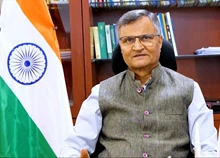
Seagrasses are submerged flowering plants found in shallow marine waters such as bays and lagoons. They require sunlight for photosynthesis, with tiny flowers and strap-like or oval leaves. A campaign aims to repopulate the UK's coasts with carbon-capturing seagrass in order to combat climate change.
While the vast majority of adults (93%) understand what is causing climate change, only about half are aware of carbon capture and its use in mitigating the harmful effects of global warming. Carbon capture is the process of removing carbon dioxide from the atmosphere. This can be accomplished through innovative technology or by anything that photosynthesizes, such as a tree. Although large rainforests like the Amazon are important for carbon capture, smaller natural resources also play an important role.
Seagrass, the plant at the heart of the WWF's Force for Nature campaign, is a prime example.
Not only do seagrass meadows capture carbon, but new research shows that sucrose accumulates beneath them at levels up to 80 times higher than previously thought. The presence of this sugar-like substance demonstrates that the plant is one of the world's largest organic carbon stores.
"Seagrass captures carbon in the same way that grass does on land." "It just uses the sun's energy to make energy," said Alec Taylor, WWF's head of the land-use climate programme.
Taylor explains that seagrass is particularly good at rapidly harvesting carbon, working more than 30 times faster than a terrestrial rainforest. Because seagrass can remain undisturbed underwater for thousands of years, it can also remove carbon.
"A tree may absorb carbon, but when it is cut down, the carbon is released back into the atmosphere. Seagrass can cling to it and bury it in its roots." Seagrass is also excellent for creating habitat for young fish and beautiful ecosystems for snorkelers to enjoy.
Replanting Seagrass Globally
The WWF's plan is to repopulate UK's coasts with seagrass. There was far more seagrass along the coasts hundreds of years ago. However, the United Kingdom has been one of the world's worst at protecting its natural resources. In the last century, 92% of the UK's seagrass has vanished.
"The UK's natural habitats are a critical ally in the fight against climate change, but they are rapidly depleting." "From wildflower meadows to peat bogs, kelp forests to seagrass, we must protect these vital assets and secure their future – for our own sake," said Tanya Steele, WWF's Chief Executive.
The campaign hopes to plant 30,000 square metres of seagrass habitat in Southampton's Solent, roughly the size of three football fields. In recent months, the government has said some really nice things about it. But now we need to see some of those words translated into action. But, as Taylor points out, this is only the beginning of the project. "Hopefully, we'll be able to use that to scale up things like seagrass restoration from a few hectares to a few hundred."
The government's investment will be critical to the project's expansion. Taylor believes that, with COP27 approaching, the government should do more than just talking about climate efforts. "The government has said some really nice things about it in recent months." But now we need to see some of those words translated into action."
The WWF wants to see increased investment in natural resources such as seagrass. They also want rules that treat restoration efforts the same as environmentally destructive projects, requiring fees and complex approval processes to be removed.
How to involve in bringing seagrass back?
The campaign is about more than just reintroducing seagrass to Britain's coasts; it's also about educating people about the importance of natural resources in mitigating the effects of climate change.
The WWF's collaboration with Sky Zero for 'Force for Nature' asks the public to sign a petition urging the government to keep its climate promises. Force for Nature will plant 4,000 seagrass seeds for every 1,000 people who sign up.
"We'll need a lot of help filling the sacks with sand, planting the seeds, and getting the seagrass seeds out into the water. Ultimately, the heart of this campaign is showing people that these incredible habitats are carbon-capture machines, in addition to all of the other benefits that they have," Taylor concludes.
Seagrasses provide a variety of ecosystem services in addition to carbon sequestration. 'Ecosystem Engineers' is the title given to them. Seagrasses help to keep the water clean & Clear by trapping fine sediments and suspended particles in the water column. Before nutrients released by land-based industries reach sensitive habitats like coral reefs, they are filtered by seagrasses.











